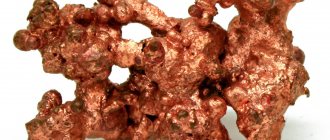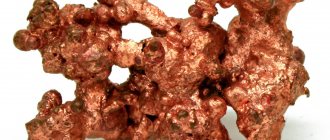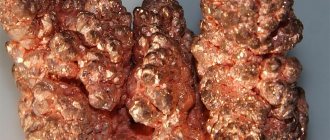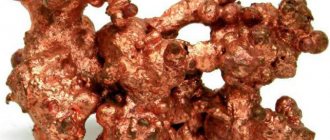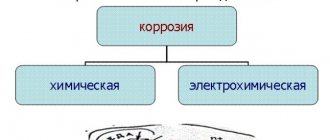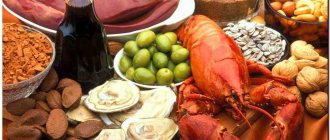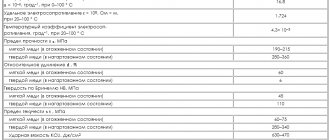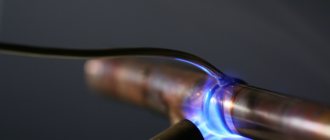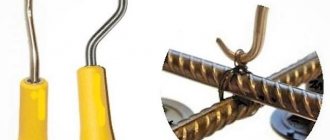Native copper measuring about 4 cm
Copper
- a mineral from the class of native elements. Fe, Ag, Au, As and other elements are found in natural minerals as impurities or forming solid solutions with Cu. The simple substance copper is a ductile transition metal of golden-pink color (pink in the absence of an oxide film). One of the first metals widely mastered by man due to its relative availability for extraction from ore and low melting point. It is one of the seven metals known to man since very ancient times. Copper is an essential element for all higher plants and animals.
- Structure
- Properties
- Reserves and production
- Origin
- Application
- Classification
- Physical properties
- Optical properties
- Crystallographic properties
See also:
Gold
— structure and physical properties
Aluminum
— structure and physical properties
STRUCTURE
Crystal structure of copper
Cubic system, hexaoctahedral type of m3m symmetry, crystal structure - cubic face-centered lattice. The model is a cube of eight atoms in the corners and six atoms located in the center of the faces (6 faces). Each atom of a given crystal lattice has a coordination number of 12. Native copper occurs in the form of plates, spongy and solid masses, thread-like and wire-like aggregates, as well as crystals, complex twins, skeletal crystals and dendrites. The surface is often covered with films of “copper green” (malachite), “copper blue” (azurite), copper phosphates and other products of its secondary alteration.
PROPERTIES
Native copper crystals, Lake Superior, Kinawee County, Michigan, USA. Size 12 x 8.5 cm
Copper is a golden-pink ductile metal; in air it quickly becomes covered with an oxide film, which gives it a characteristic intense yellowish-red hue. Thin films of copper have a greenish-blue color when exposed to light.
Along with osmium, cesium and gold, copper is one of the four metals that have a distinct coloration that is different from the gray or silver of other metals. This color tint is explained by the presence of electronic transitions between the filled third and half-empty fourth atomic orbitals: the energy difference between them corresponds to the wavelength of orange light. The same mechanism is responsible for the characteristic color of gold.
Copper has high thermal and electrical conductivity (it ranks second in electrical conductivity among metals after silver). Specific electrical conductivity at 20 °C: 55.5-58 MS/m. Copper has a relatively large temperature coefficient of resistance: 0.4%/°C and is weakly dependent on temperature over a wide temperature range. Copper is diamagnetic.
There are a number of copper alloys: brass - with zinc, bronze - with tin and other elements, cupronickel - with nickel and others.
Metal properties
Copper is in the 11th group of the periodic table of Mendeleev, in the so-called “trinity of expensive metals” - copper, gold, silver. Atomic number 29. The color of the metal is yellowish-pink, close to orange.
In the classification, the element is in the group of transition metals.
The physical properties have been appreciated for a long time, and they are still in demand. This has excellent thermal and electrical conductivity. In these indicators, copper is second only to silver; the presence of impurities (tin, iron, arsenic) worsens the performance.
Pure copper is soft, malleable, and easy to roll. The wire can be brought to a diameter of thousandths of a millimeter.
Density 8.92 g/cm3. Melts at 1083.4 °C, boils at 2567 °C.
| Properties of the atom | |
| Name, symbol, number | Copper/Cuprum (Cu), 29 |
| Atomic mass (molar mass) | 63.546(3)[1] a. e.m. (g/mol) |
| Electronic configuration | [Ar] 3d10 4s1 |
| Atomic radius | 128 pm |
| Chemical properties | |
| Covalent radius | 117 pm |
| Ion radius | (+2e) 73 (+1e) 77 (K=6) rm |
| Electronegativity | 1.90 (Pauling scale) |
| Electrode potential | +0.337 V/ +0.521 V |
| Oxidation states | 3, 2, 1, 0 |
| Ionization energy (first electron) | 745.0 (7.72) kJ/mol (eV) |
| Thermodynamic properties of a simple substance | |
| Density (at normal conditions) | 8.92 g/cm³ |
| Melting temperature | 1356.55 K (1083.4 °C) |
| Boiling temperature | 2567 °C |
| Ud. heat of fusion | 13.01 kJ/mol |
| Ud. heat of vaporization | 304.6 kJ/mol |
| Molar heat capacity | 24.44[2] J/(K mol) |
| Molar volume | 7.1 cm³/mol |
| Crystal lattice of a simple substance | |
| Lattice structure | cubic face-centered |
| Lattice parameters | 3.615 Å |
| Debye temperature | 315 K |
| Other characteristics | |
| Thermal conductivity | (300 K) 401 W/(m K) |
| CAS number | 7440-50-8 |
We recommend: MELCHIOR - lost and found
The crystal structure of the lattice is face-centric, cubic.
The chemical properties of the element are attractive to industry:
- Metallic copper is quite stable and inactive. The spiers of old churches were covered with copper sheets, which regularly protected the roof for many years.
- Exhibits oxidation states of 3, 2, 1, 0.
- The metal does not dissolve in dilute sulfuric and hydrochloric acids, but concentrated nitric acid readily reacts with copper.
- Reacts easily with sulfur and halogens (iodine, fluorine, chlorine).
In nature it consists of the isotopes 63Cu and 65Cu.
Copper connections
Copper sulfate and copper sulfate are most often found in nature. Summer residents and gardeners know this blue powder well. It is used to disinfect plants from insects.
Copper acetate is a fungicide, a component of ceramic paint.
Parisian (Schweinfurt) green, copper acetate arsenide. It is still used to paint the outer parts of sea vessels (so that they do not become overgrown with mollusks and other marine life). Fungicide, insecticide.
Oxides are used in the coloring of glass and enamels.
Nitrates are used for patination of copper products.
Over time, a natural patina forms on them - a greenish oxide-carbonate film. Sometimes patina is increased artificially to age it and give an antique look to the product.
RESERVES AND PRODUCTION
Copper specimen, 13.6 cm. Kinawi Peninsula, Michigan, USA
The average copper content in the earth's crust (clarke) is (4.7-5.5) 10−3% (by mass). In sea and river water the copper content is much lower: 3·10−7% and 10−7% (by weight), respectively. Most copper ore is mined by open pit mining. The copper content in the ore ranges from 0.3 to 1.0%. World reserves in 2000 were, according to experts, 954 million tons, of which 687 million tons were proven reserves; Russia accounted for 3.2% of total and 3.1% of confirmed world reserves. Thus, at the current rate of consumption, copper reserves will last approximately 60 years. Copper is obtained from copper ores and minerals. The main methods for obtaining copper are pyrometallurgy, hydrometallurgy and electrolysis. The pyrometallurgical method involves obtaining copper from sulfide ores, for example, chalcopyrite CuFeS2. The hydrometallurgical method involves dissolving copper minerals in dilute sulfuric acid or ammonia solution; From the resulting solutions, copper is replaced by metallic iron.
Copper, atomic properties, chemical and physical properties.
Cu 29 Copper
63.546(3) 1s2 2s2 2p6 3s2 3p6 3d10 4s1
Copper is an element of the periodic system of chemical elements of D.I. Mendeleev with atomic number 29. It is located in the 11th group (according to the old classification - a secondary subgroup of the first group), the fourth period of the periodic system.
Copper atom and molecule. Copper formula. Structure of the copper atom
Copper price
Isotopes and modifications of copper
Properties of copper (table): temperature, density, pressure, etc.
Physical properties of copper
Chemical properties of copper. Interaction of copper. Chemical reactions with copper
Copper production
Copper Applications
Table of chemical elements D.I. Mendeleev
ORIGIN
Small nugget of copper
Typically, native copper is formed in the oxidation zone of some copper sulfide deposits in association with calcite, native silver, cuprite, malachite, azurite, brochantite and other minerals. The masses of individual clusters of native copper reach 400 tons. Large industrial deposits of native copper, along with other copper-containing minerals, are formed when volcanic rocks (diabases, melaphyres) are exposed to hydrothermal solutions, volcanic vapors and gases enriched in volatile copper compounds (for example, the Lake Superior deposit, USA). Native copper is also found in sedimentary rocks, mainly in cuprous sandstones and shales. The most famous deposits of native copper are the Turin mines (Urals), Dzhezkazgan (Kazakhstan), in the USA (on the Keweenaw Peninsula, in the states of Arizona and Utah).
APPLICATION
Copper bracelets
Due to its low resistivity, copper is widely used in electrical engineering for the manufacture of power cables, wires or other conductors, for example, in printed circuit wiring. Copper wires, in turn, are also used in the windings of energy-saving electric drives and power transformers. Another useful quality of copper is its high thermal conductivity. This allows it to be used in various heat removal devices and heat exchangers, which include well-known radiators for cooling, air conditioning and heating. Alloys using copper are widely used in various fields of technology, the most widespread of which are the above-mentioned bronze and brass. Both alloys are general names for a whole family of materials, which in addition to tin and zinc may include nickel, bismuth and other metals. In jewelry, alloys of copper and gold are often used to increase the resistance of products to deformation and abrasion, since pure gold is a very soft metal and is not resistant to these mechanical influences. The predicted new mass use of copper promises to be its use as bactericidal surfaces in medical institutions to reduce intra-hospital bacterial transfer: doors, handles, water stop valves, railings, bed rails, table tops - all surfaces touched by the human hand.
Copper - Cu
| Molecular weight | 63.55 g/mol |
| origin of name | From the Greek "Kyprium", that is, "Cypriot metal", after the name of the island of Cyprus |
| IMA status | valid, first described before 1959 (before IMA) |
General information:
| 100 | General information | |
| 101 | Name | Copper |
| 102 | Former name | |
| 103 | Latin name | Cuprum |
| 104 | English name | Copper |
| 105 | Symbol | Cu |
| 106 | Atomic number (number in table) | 29 |
| 107 | Type | Metal |
| 108 | Group | Transitional, heavy, non-ferrous metal |
| 109 | Open | Known since ancient times |
| 110 | Opening year | 9000 BC |
| 111 | Appearance, etc. | Plastic metal of golden-pink color (or pink in the absence of an oxide film) |
| 112 | Origin | Natural material |
| 113 | Modifications | |
| 114 | Allotropic modifications | |
| 115 | Temperature and other conditions for the transition of allotropic modifications into each other | |
| 116 | Bose-Einstein condensate | |
| 117 | 2D materials | |
| 118 | Content in the atmosphere and air (by mass) | 0 % |
| 119 | Content in the earth's crust (by mass) | 0,0068 % |
| 120 | Content in seas and oceans (by mass) | 3,0·10-7 % |
| 121 | Content in the Universe and space (by mass) | 6,0·10-6 % |
| 122 | Abundance in the Sun (by mass) | 0,00007 % |
| 123 | Content in meteorites (by mass) | 0,011 % |
| 124 | Content in the human body (by weight) | 0,0001 % |
PHYSICAL PROPERTIES
| Mineral color | copper-red, fading to black or green in air |
| Stroke color | copper red |
| Transparency | opaque |
| Shine | metal |
| Cleavage | No |
| Hardness (Mohs scale) | 2,5-3 |
| Strength | malleable |
| Kink | jagged |
| Density (measured) | 8.94 - 8.95 g/cm3 |
| Radioactivity (GRapi) | 0 |
| Magnetism | diamagnetic |
Chemical properties of copper:
| 300 | Chemical properties | |
| 301 | Oxidation states | -2, 0, +1, +2 , +3, +4 |
| 302 | Valence | I, II |
| 303 | Electronegativity | 1.90 (Pauling scale) |
| 304 | Ionization energy (first electron) | 745.48 kJ/mol (7.726380(4) eV) |
| 305 | Electrode potential | Cu+ + e— → Cu, Eo = +0.520 V, Cu2+ + e— → Cu+, Eo = +0.153 V, Cu2+ + 2e— → Cu, Eo = +0.337 V |
| 306 | Electron affinity energy of an atom | 118.4 kJ/mol |
CRYSTALLOGRAPHIC PROPERTIES
| Point group | m3m (4/m 3 2/m) - hexoctahedral |
| Space group | Fm3m (F4/m 3 2/m) |
| singonia | cubic |
| Cell Options | a = 3.615Å |
| Morphology | cubes, dodecahedrons and tetrahexahedrons; rarely octahedra and complex combinations; thread-like, tree-like |
| Twinning | {111} twins according to the spinel law |
